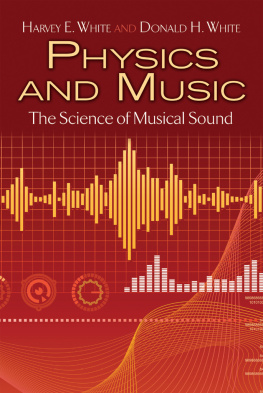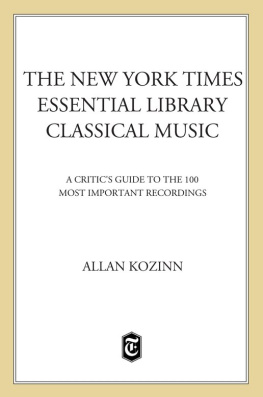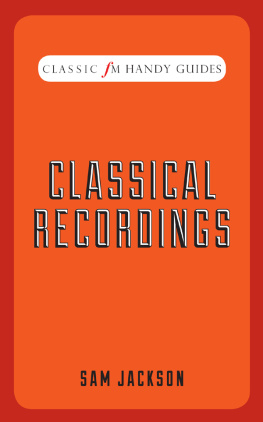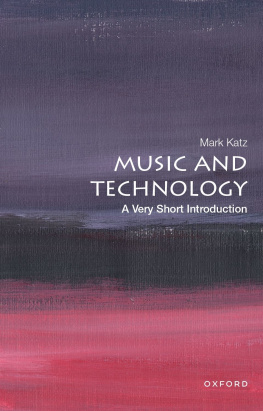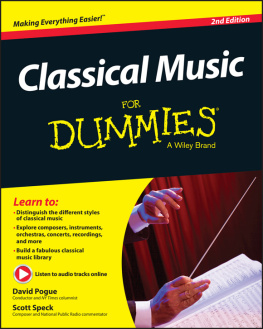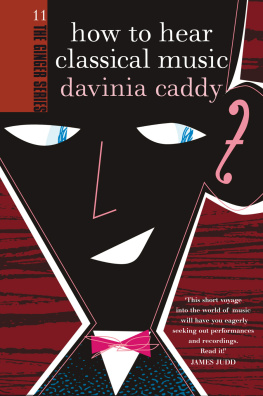
THE AHMANSON FOUNDATION
has endowed this imprint
to honor the memory of
FRANKLIN D. MURPHY
who for half a century
served arts and letters,
beauty and learning, in
equal measure by shaping
with a brilliant devotion
those institutions upon
which they rely.
The publisher gratefully acknowledges the generous support of the Ahmanson Foundation Humanities Endowment Fund of the University of California Press Foundation.
Absolute Music, Mechanical Reproduction
Absolute Music,
Mechanical Reproduction
ARVED ASHBY

University of California Press, one of the most distinguished university presses in the United States, enriches lives around the world by advancing scholarship in the humanities, social sciences, and natural sciences. Its activities are supported by the UC Press Foundation and by philanthropic contributions from individuals and institutions. For more information, visit www.ucpress.edu .
University of California Press
Berkeley and Los Angeles, California
University of California Press, Ltd.
London, England
2010 by The Regents of the University of California
Library of Congress Cataloging-in-Publication Data
Ashby, Arved Mark.
Absolute music, mechanical reproduction / Arved Ashby.
p. cm.
Includes bibliographical references and index.
ISBN 978-0-520-26479-3 (cloth, alk. paper) ISBN 978-0-520-26480-9 (pbk., alk. paper)
1. Absolute music. 2. Sound recordingsSocial aspects.
3. MusicPhilosophy and aesthetics. 4. Performance practice
(Music)History20th century. I. Title.
ML3854.A84 2010
781.49dc22 2009040742
Manufactured in the United States of America
19 18 17 16 15 14 13 12 11
10 9 8 7 6 5 4 3 2 1
This book is printed on Cascades Enviro 100, a 100% post consumer waste, recycled, de-inked fiber. FSC recycled certified and processed chlorine free. It is acid free, Ecologo certified, and manufactured by BioGas energy.
For Gustavo Dudamel,
poised to introduce tomorrow to
the music of yesterday
Contents
Illustrations
FIGURES
MUSICAL EXAMPLES
Acknowledgments
This book was a joy to writebecause of the importance and timeliness of its subject, certainly, but also because it brought me into contact with quite a few enthusiastic and very knowledgeable people. Book and author profited especially from the expert insights, assessments, and corrections, not to mention kind encouragement, of the anonymous readers selected by University of California Press; I hope they are satisfied with the final product. Mary Francis proved the most helpful of acquisitions editors, taking an interest in the book from the get-go, and then alternating carrots and sticks in such a way that the thing seemed to write itself all the more smoothly. Mary has my heartfelt thanks for bucking the publisher default option and being so proactive and personal. Cindy Fulton and Nick Arrivo at the Press were also very supportive in keeping things moving along. The book never would have left the ground without a half-year Faculty Professional Leave from The Ohio State University. I drafted several chapters in happy daytime seclusion in Hong Kong, where the Pun family was kind enough to put me up for an entire month. An Ohio State College of the Arts research grant, awarded through the offices of Associate Dean Mark Fullerton, made a preliminary cleanup of the entire manuscript possible at a critical time. For their astute readings of individual chapters at various points in the trajectory, I am grateful to Amy Bauer, Nicholas Cook, Kay Dickinson, Steve Jones, Karl Klug, Ralph Locke, Alejandro Madrid, Robert Morgan, Mark Obert-Thorn, and Philip Rupprecht. Jonathan Dunsby went far beyond the call of duty and read most of my first draft, and his many criticisms proved vital in giving the book focus. Joseph Panzner read through the entire final draft, and I am grateful for his many suggestions. It is a measure of Joes extraordinary scope, insight, and all-round helpfulness that a few of his aperus and thought-provoking turns of phrase remain detectable in my final prose, hard . I would like to thank not only Joe and Andrew but all of my students for teaching me so much over the years. They will never know just how much Ive learned from them, and their influence on this book has taken various forms. Anthony Vine, not least among these scholars-to-watch, came through in a pinch and did a beautiful job with the musical examples. Finally, I am delighted to thank my own original teacher. Arved Ojamaa, my father, set the wheels in motion for this book when he played nonstop Chopin and Schubert on the stereo four decades ago, and he has now taken a keen interest in every line of what follows. If Ive managed to avoid cant and jargon while showing love for my topic, it is because Dad has served, from start to finish, as my ideal reader.
Introduction
When you buy a record there are always cuts that leave you cold. You skip them. You dont approach a record as a closed book that you have to take or leave. Other cuts you may listen to over and over again. They follow you. You find yourself humming them under your breath as you go about your daily business. Brian Massumi urges readers to approach Gilles Deleuze and Flix Guattaris books Anti-Oedipus and A Thousand Plateaus, the two volumes comprising Capitalism and Schizophrenia, as if they were music albums. He presents the record as a metaphor for vernacular reading practices, as a practical way to reconcile an arcane study with everyday life.
For anyone working with art music, Massumis suggestion becomes a disciplinarity matter: it seems odd that a philosopher and political theorist should find music recordings more useful, conceptually and practically, than many musicians do. Though the recording has been serious musics main vehicle of currency for at least twenty years now, American musicologists fail to give it or other mass media much ontological recognition beyond documentary functions. Such coverage as there is comes neither from musicians nor from musicologists, strictly speaking, but from media theorists and philosophers of aesthetics. Against the substantial work on recordings from nonmusicians like Michael Chanan, Kathleen Marie Higgins, Paul Thom, Stan Godlovitch, Lee B. Brown, and Theodore Gracyk, we need to place Simon Rattles convictionnot unusual in his fieldthat music was not meant to sound like gramophone records, music ontologist Roman Ingardens distancing of the recording from the composition by invoking a record of a work in performance and not of the work itself, and Harvard musicologist Lewis Lockwoods anger that Bernard Rose dared make his Beethoven movie Immortal Beloved as a Hollywood film and not as a history textbook.
Recordings, films, and other media have enabledor, more simply, arevernacular practices with art music, and those music scholars who slight or ignore them are relics tending a relic discipline. If the same mind-set held sway in literary circles, we would be discussing the Bible as an object of oral transmission, Shakespeares dramas would be analyzed exclusively as works for the playhouse with seminars devoted to his stage directions, and Coleridges poems would be examined as inviolate wholes incapable of being excerpted or read in part, the final word immanent in the first. Musicologists speak enthusiastically of ethnography, the study of music out in the field, as used and practiced by ordinary people in ordinary life, butperhaps out of some unspoken condescensionthey tend to restrict such perspectives to popular and folk musics.
Next page



